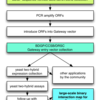Data mining
. 6/1/2017. “MARRVEL: Integration of Human and Model Organism Genetic Resources to Facilitate Functional Annotation of the Human Genome.” Am J Hum Genet, 100, 6, Pp. 843-853.Abstract
Nucleolar image-based screen dataset viewable online with OMERO
. 8/7/2017. “Gene2Function: An Integrated Online Resource for Gene Function Discovery.” G3 (Bethesda).Abstract
Plasmid clones and data available from the FlyBi project
. 5/3/2016. “Controllability analysis of the directed human protein interaction network identifies disease genes and drug targets.” Proc Natl Acad Sci U S A, 113, 18, Pp. 4976-81.Abstract
Now Available: Our 2017 NAR database issue update
. 10/11/2016. “FlyRNAi.org—the database of the Drosophila RNAi screening center and transgenic RNAi project: 2017 update.” Nucleic Acids Research. Publisher's VersionAbstract
Gene List Annotation for Drosophila (GLAD) online resource updated
"One vs. All" a new feature in our ortholog search tool
2017
Mar
29
. 9/13/2016. “An Integrative Analysis of the InR/PI3K/Akt Network Identifies the Dynamic Response to Insulin Signaling.” Cell Reports, 16, 11, Pp. 3062-3074.Abstract







